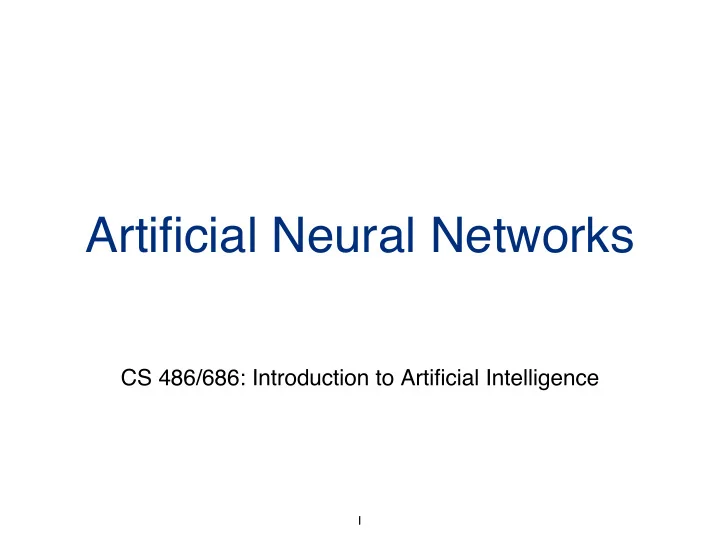

Artificial Neural Networks CS 486/686: Introduction to Artificial Intelligence 1
Introduction Machine learning algorithms can be viewed as approximations of functions that describe the data In practice, the relationships between input and output can be extremely complex. We want to: • Design methods for learning arbitrary relationships • Ensure that our methods are efficient and do not overfit the data 2
Artificial Neural Nets Idea : The humans can often learn complex relationships very well. Maybe we can simulate human learning? 3
Human Brains • A brain is a set of densely connected neurons. • A neuron has several parts: - Dendrites: Receive inputs from other cells - Soma: Controls activity of the neuron - Axon: Sends output to other cells - Synapse: Links between neurons 4
Human Brains • Neurons have two states - Firing, not firing • All firings are the same • Rate of firing communicates information (FM) • Activation passed via chemical signals at the synapse between firing neuron's axon and receiving neuron's dendrite • Learning causes changes in how efficiently signals transfer across specific synaptic junctions. 5
Artificial Brains? • Artificial Neural Networks are based on very early models of the neuron. • Better models exist today, but are usually used theoretical neuroscience, not machine learning 6
Artificial Brains? • An artificial Neuron (McCulloch and Pitts 1943) Link~ Synapse Bias Weight a 0 = 1 a j = g ( in j ) w 0 ,j Weight ~ Efficiency g in j Input Fun.~ Dendrite w i,j Σ a i a j Activation Fun.~ Soma Input Input Activation Output Output = Fire or not Output Links Function Function Links 7
Artificial Neural Nets • Collection of simple artificial neurons. • Weights denote strength of connection from i to j • Input function: • Activation Function: 8
Activation Function • Activation Function: • Should be non-linear (otherwise, we just have a linear equation) • Should mimic firing in real neurons - Active (a i ~ 1) when the "right" neighbors fire the right amounts - Inactive (a i ~ 0) when fed "wrong" inputs 9
Common Activation Functions • Rectified Linear Unit (ReLU): g(x)=max{0,x} • Sigmoid Functions: g(x)=1/(1+e x ) • Hyperbolic Tangent: g(x)=tanh(x)=(e 2x -1)/(e 2x +1) • Threshold Function: g(x)=1 if x ≥ b, 0 otherwise - (not really used in practice often but useful to explain concepts) 10
Logic Gates It is possible to construct a universal set of logic gates using the neurons described (McCulloch and Pitts 1943) 11
Logic Gates It is possible to construct a universal set of logic gates using the neurons described (McCulloch and Pitts 1943) 12
Network Structure • Feed-forward ANN - Direct acyclic graph - No internal state: maps inputs to outputs. • Recurrant ANN - Directed cyclic graph - Dynamical system with an internal state - Can remember information for future use 13
Example 14
Example 15
Perceptrons Single layer feed-forward network 16
Perceptrons Can learn only linear separators 17
Training Perceptrons Learning means adjusting the weights - Goal: minimize loss of fidelity in our approximation of a function How do we measure loss of fidelity? - Often: Half the sum of squared errors of each data point 1 X 2( y k − ( h W ( x )) k ) 2 E= k 18
Learning Algorithm - Repeat for "some time" - For each example i: 19
Multilayer Networks • Minsky's 1969 book Perceptrons showed perceptrons could not learn XOR. • At the time, no one knew how to train deeper networks. • Most ANN research abandoned. 20
Multilayer Networks • Any continuous function can be learned by an ANN with just one hidden layer (if the layer is large enough). 21
XOR 22
Training Multilayer Nets • For weights from hidden to output layer, just use Gradient Descent, as before. • For weights from input to hidden layer, we have a problem: What is y? 23
Back Propagation • Idea: Each hidden layer caused some of the error in the output layer. • Amount of error caused should be proportionate to the connection strength. 24
Back Propagation • Repeat for "some time": • Repeat for each example: - Compute Deltas and weight change for output layer, and update the weights . - Repeat until all hidden layers updated: - Compute Deltas and weight change for the deepest hidden layer not yet updated, and update it. 25
Deep Learning • Roughly “deep learning” refers to neural networks with more than one hidden layer • While in theory one only needs a single hidden layer to approximate any continuous function, if you use multiple layers you typically need less units 26
Parity Function 27
Parity Function 2n-2 hidden layers 28
Deep Learning in Practice How do you train them? 29
Image Recognition ImageNet Large Scale Visual Recognition Challenge 30
When to use ANNs • When we have high dimensional or real- valued inputs, and/or noisy (e.g. sensor data) • Vector outputs needed • Form of target function is unknown (no model) • Not import for humans to be able to understand the mapping 31
Drawbacks of ANNs • Unclear how to interpret weights, especially in many-layered networks. • How deep should the network be? How many neurons are needed? • Tendency to overfit in practice (very poor predictions outside of the range of values it was trained on) 32
Recommend
More recommend